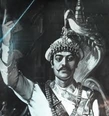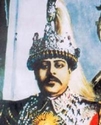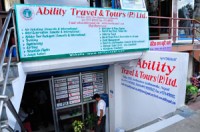Shah Kings of Nepal
The Shahs Kings were the descendents of Dravya Shah who was a Sidodia Rajpur from Chittor in modern Rajasthan with his ancestors settled in Gorkha, the region that gave them their clan name Gurkha.
It is said that there in the land of Liglig, there was a tradition of choosing a king every autumn for a year by a running race that was open to everyone. When Dravya Shah came to know about it, he decided to participate, however, with his not-so robust physic, it was impossible for him to him. So he tricked his way to win the race with the support of the Bhattarai, Aryal Adhikari, Pant and Acharya clan of Brahmin community. As soon as he became the king of LigLig, he stopped the tradition of choosing ruler through race and executed those who suggested reinstatement of the race. He also used the Magar army to invade neighboring states in order to expand his territory. After his death in 1570, the expansion mission was carried on by his successors. He is said to be the ancestor of the modern Shah Kings of Nepal.
The Shah Kings who ruled the county after its unification until the republican system was established in the country are mentioned below:
Prithvi Narayan Shah
The visionary king Prithvi Narayan Shah, the King of Gorkha was the one who unified the small states into a single nation called Nepal. Born on Poush 27, 1779 BS to King Narabhupal Shah, he conquered the small kingdoms and expanded his territory until he died at the age of fifty six. He also shifted the capital to Kathmandu and started living in Hanuman Dhoka Royal Palace (now a museum). He was succeeded by his eldest son Pratap Singh Shah.
Pratap Singh Shah
The eldest son of King Prithvi Narayan Shah, Pratap Singh Shah was born on 1751. He ruled Nepal since 1775 to 1777 and died due to natural causes. Although he did not participate in the unification process as a king, his brother continued the campaign led by their father. His two year old son Rana Bahadur Shah succeeded him as the king of Nepal.
Rana Bahadur Shah
Born on 1775, he succeeded his father at the age of two years, after his death. As he was a minor when he ascended the throne, he ruled under the regencies of his mother Queen Rajendra Laxmi (who died in 1785) and then his uncle Bahadur Shah, however, he sent his uncle to jail. The kingdom of Nepal was extended to Garhwal and Kumaon, now part of India, during his rule. Although he renounced the throne to his infant son Girvan Yuddha Bikram Shah Dev in 1799 to become an ascetic, he came back to Nepal with Bhimsen Thapa, Bal Narsingh Kunwar and other supporters and started to take active part in the role of governance until he was stabbed to death in 1806 by his stepbrother Sher Bahadur Shah.
Girvanyuddha Bikram Shah Dev
The infant king who ascended the throne at the age of one and half years, Girvanyuddha Bikram Shah Dev was born in 1797. Also known as Girvanyuddha Bikram Shah, he became the king of Nepal in 1799. He had ruled under the regency of Queen Lalit Tripura Sundari and Prime Minister Bhimsen Thapa and died at the age of 19 in 1816. During his reign, the Battle of Nalapani (Khalanga), Battle of Jaithak, Battle of Jeetgarh, Battle of Devthal, Battle of Gadhwal, Nepal-British war were fought and also the Treaty of Sugauli was signed in favor of British because of which Nepal suffered a great territorial loss. He was succeeded by his son Rajendra Bikram Shah.
Rajendra Bikram Shah
The King who ascended the throne at the age of three because of the death of his father, Girvan Yuddha Bikram Shah Dev ruled under the regency of Lalit Tripura Sundari (who died in 1832) and Prime Minister Bhimsen Thapa. Born in 1813, he ascended the throne in 1816 and during the regency of Thapa, he was not allowed to leave the palace without permission.
In 1837, he stripped Bhimsen Thapa and Mathbar Singh of their military authority and shortly after that, his youngest son from elder queen died. He then arrested Thapa on the false charges of poisoning the prince and confiscated all the property of Thapas. Although Thapa was released after an eight-month trial, he was imprisoned again by the newly appointed Prime Minister Rana Jang Pande and committed suicide in prison in 1839.
The Kot Massacre, which gave way to the rise of Jung Bahadur Rana who established the familial rule of Ranas, occurred during his period. He was kept under house arrest in 1847 in Bhaktapur where he spent rest of his life (until 1881). He was succeeded by his son Surendra Bikram Shah during his lifetime.
Surendra Bikram Shah
Born on 1829, Surendra Bikram Shah became the King of Nepal after Prime Minister Jung Bahadur Rana forced the renunciation of his father Rajendra Bikram Shah. During his reign, the country was ruled mostly by Jung Bahadur Rana. His son Crown Prince Trilokya Bir Bikram Shah had married two of Jung Bahadur Rana’s daughters. Trilokya, however, could not succeed his father as he died in 1878, leaving the throne to his son, Surendra’s grandson, Prithvi Bir Bikram Shah. King Surendra died in 1881.
Prithvi Bir Bikram Shah
Born in 1875, Prithvi Bir Bikram Shah succeeded his grandfather as the King of Nepal in 1881. The most important event that happened during his reign was the introduction of the first automobiles to Nepal and also the creation of strict water and sanitation systems for the country. His eldest child was HRN Princess Royal Laxmi Rajya Laxmi Devi Shah who was married to Field Marshal Kaiser SJB Rana. Her brother King Tribhuvan Bir Bikram Shah Dev was born when she was in her late teens, till then, she was made the Crown Princess and the heir to the throne. He died in the year 1911.
Tribhuvan Bir Bikram Shah Dev
Born in 1906, King Tribhuvan Bir Bikram Shah Dev is also called the father of the nation. He played an important role in establishing the democratic system in the country for the first time with the help of his people. The multiparty democracy system was established in the country during his reign overthrowing the century old familial Rana reign. He was succeeded by his son King Mahendra, after his death.
Mahendra Bir Bikram Shah Dev
Although he ascended the throne of a democratic country in 1955 after the death of his father, King Mahendra suspended the constitution, dissolved the parliament, dismissed the cabinet and imposed direct rule in the country establishing the Panchayat system of governance.
The East-West Highway, also known as the Mahendra highway was constructed during his reign. Born in 1920, King Mahendra ruled Nepal until 1972 when he died of heart attack.
Birendra Bir Bikram Shah Dev
Born in 1945, King Birendra succeeded his father in the year 1972 after his death. During his reign, the democracy was reestablished in the country and the Panchayat was abolished. Many development activities took place during his reign, however, due to the disagreements in political ideologies, a group of rebel rose calling themselves Maoists and declared more than a decade long civil war in the country. He died in 2001 in the Royal Massacre said to be operated by his son King Dipendra (he killed his family and relatives before killing himself) in which all of his family members died along with three of his siblings. His son Dipendra died two days after being declared the King of Nepal while he was in coma.
Dipendra Bir Bikram Shah Dev
Born on 27 June 1971, King Dipendra was the only Crown Prince who became the King for three days, that too in the state of coma. It is said that he had masterminded and executed the Nepalese Royal Massacre of 2001 that left all of his family members and most of his relatives dead. He also shot himself in chest after the executing the massacre and was in coma for three days. He was declared the King on June 1, 2001 and died on June 4, 2001.
Gyanendra Bir Bikram Shah Dev
The last ruling King of the Shah dynasty in Nepal, King Gyanendra was born in 1947. He succeeded his nephew King Dipendra after his death as no member of his brother’s family survived the cruel massacre. He was overthrown by the people of Nepal in 2008 after he tried and imposed the absolute monarchy in 2006. He lives at his private residence in Maharajgunj with his wife while his son Paras lives in abroad and is constantly caught in controversies.









Pingback: Can Nepal Realistically Look to China as an Alternative Trade Partner?
Pingback: Can Nepal Realistically Look to China as an Alternative Trade Partner? – Counter Information